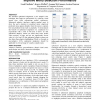Free Online Productivity Tools
i2Speak
i2Symbol
i2OCR
iTex2Img
iWeb2Print
iWeb2Shot
i2Type
iPdf2Split
iPdf2Merge
i2Bopomofo
i2Arabic
i2Style
i2Image
i2PDF
iLatex2Rtf
Sci2ools
CHI
2009
ACM
2009
ACM
Ephemeral adaptation: the use of gradual onset to improve menu selection performance
We introduce ephemeral adaptation, a new adaptive GUI technique that improves performance by reducing visual search time while maintaining spatial consistency. Ephemeral adaptive interfaces employ gradual onset to draw the user's attention to predicted items: adaptively predicted items appear abruptly when the menu is opened, but non-predicted items fade in gradually. To demonstrate the benefit of ephemeral adaptation we conducted two experiments with a total of 48 users to show: (1) that ephemeral adaptive menus are faster than static menus when accuracy is high, and are not significantly slower when it is low and (2) that ephemeral adaptive menus are also faster than adaptive highlighting. While we focused on user-adaptive GUIs, ephemeral adaptation should be applicable to a broad range of visually complex tasks. Author Keywords Adaptive interfaces, personalization, abrupt visual onset, menu design, user study, interaction techniques. ACM Classification Keywords H.5.2 [User Int...
CHI 2009 | Ephemeral Adaptation | Ephemeral Adaptive Interfaces | Ephemeral Adaptive Menus | Human Computer Interaction |
| Added | 24 Nov 2009 |
| Updated | 24 Nov 2009 |
| Type | Conference |
| Year | 2009 |
| Where | CHI |
| Authors | Leah Findlater, Karyn Moffatt, Joanna McGrenere, Jessica Q. Dawson |
Comments (0)

